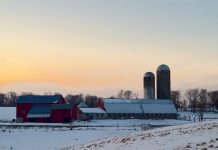As usual, Ohio weather has been highly variable across the state during the forage growing season. Luckily, at least in Southeastern Ohio, we have been blessed with ample moisture thus far, and pastures continue to be in decent shape.
As fall approaches, this time of year is as good as any to evaluate your forage resources and determine if you’re going to have enough forage into August and beyond. Seems like due to dry weather this spring, hay was made timely. That is positive with regard to quality; however, tonnage may be a concern.
1. Stockpiling fescue. This time-tested option works well in Ohio and is beginning to look more attractive as nitrogen prices come down from their highs earlier in the year. It only takes around 50 pounds of nitrogen per acre to see an increased dry matter yield in stockpiled fescue.
While getting a bit late, there is still time to consider stockpiling and taking advantage of fall regrowth by removing cattle or mowing off seed heads. Typically done with fescue, stockpiled forage can extend the grazing season into late fall and early winter. Consider stockpiled fields as potential calving/lambing sites.
2. Load the bus. Livestock prices remain very strong, and on the beef side of things, it looks to be that way for some time given the drought in the West (see below). Even so, culling non-productive females can help if feed is in short supply.
Pregnancy checking is an easy-to-do and cost-effective measure, yet it is a highly under-utilized tool. Identify pregnant and non-pregnant females and make the first round of culling decisions based on pregnancy status. Non-pregnant or open females can negate potential profits.
Evaluate those who are pregnant for structure, temperament and performance. Those who don’t check all the boxes should be first in line for the one-way bus trip to town.
Utilize body condition scoring at weaning. Cull cows that struggle to maintain body condition. If feed is available, mid-gestation is a prime time to provide extra resources to improve BCS.
3. Manage pasture weeds. Seems like pasture weeds are as healthy as ever. The ones that stand out in my mind are cocklebur and hemp dogbane. Cocklebur fortunately is easily controlled with most of our available broadleaf herbicides, while hemp dogbane is a bit hardier. Remember that once the plant — especially if it is a perennial — goes to seed, we have missed our window for mechanical weed control.
4. Consider hay inventory. Feed old hay first. If pastures are looking short, now is a time to consider feeding some of that leftover hay from 2022, especially if it’s dry hay that has been stored outdoors. We should feed lower-quality hay to those dry females in mid-gestation.
Significant dry matter has already been lost to the elements and those bales will continue to lose nutrients and value as they weather.
5. Winter annuals. Oats planted after Aug. 1, and triticale, wheat and rye, planted in early to mid-October, make for great spring grazing with the potential to make stored baleage or silage as well. As a beef team, we have several resources available regarding raising winter annual forages.













